Nanotechnology is today perhaps the most promising research field in the world. In the future, scientists believe that a large number of innovations will be based on it, ranging from better solar sensors, to better computer and electronics devices, and better treatments for a large number of conditions. However, in order to be used inside the body, the nanoparticles need to be deemed safe first. That is to say, experts need to prove that no harmful interactions occur between blood vessels, organs and brains, on the one hand, and the unfathomably small particles on the other, AlphaGalileo reports.
Experts envision using nanoscale sensors in the future for studying how learning and memory take place inside the brain, and also for treating patients suffering from chronic pain. Diseases such as Parkinson's and depression could also fall victim to the new therapies. Additionally, drug- or gene-loaded nanoparticles will be inserted in the body in the near future, to deliver a fast punch into any tumor or infection at exactly the right place and time, without killing any friendly cells.
The issue of hot debates in the international community at this point is what would happen if the nanoscale electrodes came loose from their anchor points, and started drifting through the body or brain. In an effort to answer this question, scientists from the Swedish Lund University decided to inject nanowires resembling the electrode nodes of the future into the brains of mice, and see what happened. They noticed that the microglial cells, the body's clean-up cells, gradually disposed of the intruders.
12 weeks after the original injection, only minor differences could be noticed between the study and the control group. “The results indicate that this is a feasible avenue to pursue in the future. Now we have a better base on which to develop more advanced and more useful electrodes than those we have today,” LU Faculty of Engineering Solid State Physics scientist Christelle Prinz says.
Prinz is the lead author of a new article detailing the finds, entitled “Nanowire biocompatibility in the brain – Looking for a needle in a 3D stack,” published in the latest issue of the scientific journal Nano Letters. LU Faculty of Medicine expert Cecilia Eriksson Linsmeier has been the co-lead author on the paper. The study was conducted under a Linnaeus grant, with money from the Wallenberg Foundation.
“We studied two of the brain tissue's support cells: on the one hand, microglia cells, whose job is to 'tidy up' junk and infectious compounds in the brain and, on the other hand, astrocytes, who contribute to the brain's healing process. The microglia 'ate' most of the nanowires. In weeks 6 and 12 we could see remains of them in the microglia cells,” Neuronano Research Center (NRC) researcher Nils Danielsen explains.
“Together with other findings and given that the number of microglial cells decreased over time, the results indicate that the brain was not damaged or chronically injured by the nanowires,” Prinz adds.

 14 DAY TRIAL //
14 DAY TRIAL //